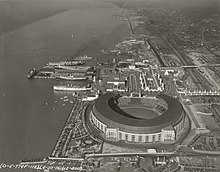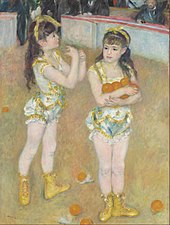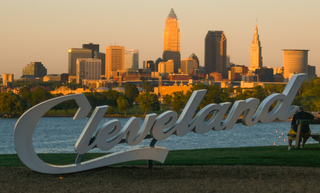
Cleveland, officially the City of Cleveland, is a city in the U.S. state of Ohio and the county seat of Cuyahoga County. Located in Northeast Ohio along the southern shore of Lake Erie, it is situated across the U.S. maritime border with Canada and lies approximately 60 miles (97 km) west of Pennsylvania. Cleveland ranks as the most populous city on Lake Erie, the second-most populous city in Ohio, and the 54th-most populous city in the U.S. with a 2020 population of 372,624. The city anchors the Cleveland metropolitan area, the 33rd-largest in the U.S. at 2.18 million residents, as well as the larger Cleveland–Akron–Canton combined statistical area, the most populous in Ohio and the 17th-largest in the country with a population of 3.63 million in 2020.

Futurama was an exhibit and ride at the 1939 New York World's Fair designed by Norman Bel Geddes, which presented a possible model of the world 20 years into the future (1959–1960). The installation was sponsored by the General Motors Corporation and was characterized by automated highways and vast suburbs.

A Century of Progress International Exposition, also known as the Chicago World's Fair, was a world's fair held in the city of Chicago, Illinois, United States, from 1933 to 1934. The fair, registered under the Bureau International des Expositions (BIE), celebrated the city's centennial. Designed largely in Art Deco style, the theme of the fair was technological innovation, and its motto was "Science Finds, Industry Applies, Man Conforms", trumpeting the message that science and American life were wedded. Its architectural symbol was the Sky Ride, a transporter bridge perpendicular to the shore on which one could ride from one side of the fair to the other.

The 1964–1965 New York World's Fair was a world's fair that held over 140 pavilions and 110 restaurants representing 80 nations, 24 U.S. states, and over 45 corporations with the goal and the final result of building exhibits or attractions at Flushing Meadows–Corona Park in Queens, New York City. The immense fair covered 646 acres (2.61 km2) on half the park, with numerous pools or fountains, and an amusement park with rides near the lake. However, the fair did not receive official support or approval from the Bureau of International Expositions (BIE).
Cedar Point is a 364-acre (147 ha) amusement park located on a Lake Erie peninsula in Sandusky, Ohio, United States. It opened in 1870 and is considered the second-oldest operating amusement park in the US behind Lake Compounce. Cedar Point, which is owned and operated by Cedar Fair, is the flagship of the company's amusement park chain. Known as "America's Roller Coast", the park features 16 roller coasters, which ranks third among amusement parks in North America behind Six Flags Magic Mountain (20) and Canada's Wonderland (18). Cedar Point's normal operating season runs from early May until Labor Day in September, which is followed by weekend-only operation through Halloween during an annual event known as HalloWeekends. Other amenities and attractions featured within the park include a one-mile-long (1.6 km) beach, an outdoor water park named Cedar Point Shores, an indoor water park named Castaway Bay, two marinas, and an outdoor sports complex called Cedar Point Sports Center.

The 1939–1940 New York World's Fair was a world's fair held at Flushing Meadows–Corona Park in Queens, New York City, United States. It was the second-most expensive American world's fair of all time, exceeded only by St. Louis's Louisiana Purchase Exposition of 1904. Many countries around the world participated in it, and over 44 million people attended its exhibits in two seasons. It was the first exposition to be based on the future, with an opening slogan of "Dawn of a New Day", and it allowed all visitors to take a look at "the world of tomorrow".

Billy Rose was an American impresario, theatrical showman, lyricist and columnist. For years both before and after World War II, Billy Rose was a major force in entertainment, with shows such as Billy Rose's Crazy Quilt (1931), Jumbo (1935), Billy Rose's Aquacade (1937), and Carmen Jones (1943). As a lyricist, he is credited with many songs, notably "Don't Bring Lulu" (1925), "Tonight You Belong To Me" (1926), "Me and My Shadow" (1927), "More Than You Know" (1929), "Without a Song" (1929), "It Happened in Monterrey" (1930), and "It's Only a Paper Moon" (1933).

The Texas Centennial Exposition was a world's fair presented from June 6 to November 29, 1936, at Fair Park, Dallas, Texas. A celebration of the 100th anniversary of Texas's independence from Mexico in 1836, it also celebrated Texas and Western American culture. More than 50 buildings were constructed for the exposition, and many remain today as notable examples of Art Deco architecture. Attracting more than six million people including US President Franklin Roosevelt, the exposition was credited with buffering Dallas from the Great Depression.
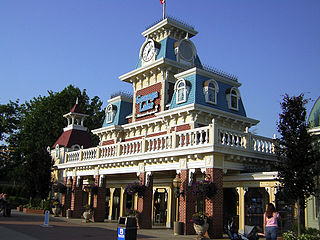
Geauga Lake was an amusement park in Bainbridge Township and Aurora, Ohio. It was established in 1887, in what had been a local recreation area adjacent to a lake of the same name. The first amusement ride was added in 1889, and the park's first roller coaster – the Big Dipper – was built in 1925. The park was sold to Funtime, Inc., in 1969 and was expanded over the years with additional rides and amenities. Funtime was acquired by Premier Parks in 1995, and for the 2000 season, they re-branded Geauga Lake as Six Flags Ohio, adding four new roller coasters. The following year, Six Flags bought the adjacent SeaWorld Ohio and combined the two parks under the name Six Flags Worlds of Adventure.

Tower City Center is a large mixed-use facility in Downtown Cleveland, Ohio, on its Public Square. The facility is composed of a number of interconnected office buildings, including Terminal Tower, the Skylight Park mixed-use shopping center, Jack Cleveland Casino, Renaissance Cleveland Hotel, Chase Financial Plaza, and Tower City station, the main hub of Cleveland's four RTA Rapid Transit lines.

The Great Lakes Science Center is a museum and educational facility in downtown Cleveland, Ohio, United States. Many of the exhibits document the features of the natural environment in the Great Lakes region of the United States. The facility includes signature (permanent) and traveling exhibits, meeting space, a cafe, and an IMAX Dome theater.

Euclid Beach Park was an amusement park located on the southern shore of Lake Erie in the Collinwood neighborhood of Cleveland, Ohio, which operated from 1895 to 1969.

Higbee's was a department store founded in 1860 in Cleveland, Ohio. In 1987, Higbee's was sold to the joint partnership of Dillard's department stores and Youngstown-based developer, Edward J. DeBartolo. The stores continued to operate under the Higbee name until 1992, when DeBartolo sold his shares to his partners and the chain was re-branded as Dillard's.

The Golden Gate International Exposition (GGIE) (1939 and 1940), held at San Francisco's Treasure Island, was a World's Fair celebrating, among other things, the city's two newly built bridges. The San Francisco–Oakland Bay Bridge opened in 1936 and the Golden Gate Bridge in 1937. The exposition opened from February 18, 1939, through October 29, 1939, and from May 25, 1940, through September 29, 1940; it drew 17 million visitors to Treasure Island.
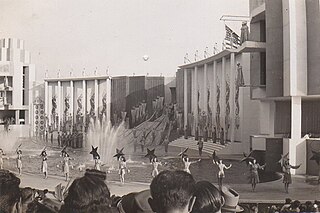
Billy Rose's Aquacade was a music, dance and swimming show produced by Billy Rose at the Great Lakes Exposition in Cleveland, Ohio during its second year, in 1937. The show featured Olympians Johnny Weissmuller, Eleanor Holm Jarret, Dick Degener, and other performers in a 5,000-seat amphitheater that could seat 2,000 diners. There was a 128 foot wide floating stage constructed on barges that could be moved to shore electrically for use as a dance floor. Dance bands such as Wayne King, Shep Fields, and Glen Gray and his Casa Loma Orchestra performed there.
SeaWorld Ohio was a theme park and marine zoological park located in Aurora, Ohio. It was owned and operated by SeaWorld Parks & Entertainment, formerly known as Busch Entertainment Corporation. The Ohio location was the second SeaWorld park to be built in the chain, following SeaWorld San Diego, which opened six years earlier. The park was developed by George Millay, founder of the SeaWorld brand. After being purchased by Six Flags, the park was merged with Six Flags Ohio, an amusement park nearby, and converted to Wildwater Kingdom, which occupied the property until its closure in September 2016.
White City is the common name of dozens of amusement parks in the United States, the United Kingdom, and Australia. Inspired by the White City and Midway Plaisance sections of the World's Columbian Exhibition of 1893, the parks started gaining in popularity in the last few years of the 19th century. After the 1901 Pan-American Exposition inspired the first Luna Park in Coney Island, a frenzy in building amusement parks ensued in the first two decades of the 20th century.

The Great Industrial Exposition of Berlin 1896 was a large exposition that has also been dubbed "the impeded world fair".

Clarence E Willard was an American vaudeville performer. After carrying out stretching exercises, Willard found he was able to increase his height at will by 7+1⁄2 inches (19 cm) and also elongate his arms and legs. He developed this into a freak show act under the name "The Man Who Grows". From around 1910 Willard performed in vaudeville in the United States and was also claimed to have performed at the Berlin Wintergarten theatre. He became associated with Robert Ripley, performing at the Believe It or Not! odditoriums and appearing in a short film. Willard appeared at the 1936–37 Great Lakes Exposition in Cleveland, Ohio, and later ran a restaurant in Alameda, California.
